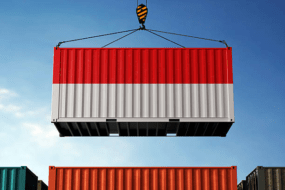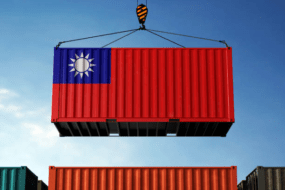- Home
- Trade News
- Russian trade surplus growth p ...

Because of an unprecedented trade surplus, Russia’s current-account surplus in the second quarter of 2022 was at its greatest level ever. This is partially due to increased fossil fuel income brought on by higher prices, which have assisted in funding Putin’s war.
However, the increased revenue is only a portion of the whole picture. Russia’s trade surplus has increased, but approximately over half of that growth is attributable to sharply declining imports from Russia, which may eventually hurt the country’s ability to produce.
Concealing Russia’s economic data
After Russia invaded Ukraine, the Russian central bank ceased to provide extensive trade statistics. Access to all statistics on international commerce, including those pertaining to exports, imports, and trade inside the Eurasian Economic Union, has been regulated by the Russian government since April 2022. (EAEU).
Prior until now, the Kremlin’s vitally important oil and gas supplies, which are presently bringing in record surpluses, could be traced by looking at Russian export figures. Bloomberg forecasts that Russia will receive a record $285 billion from oil and gas exports in 2022. According to official Russian figures, oil and gas income to the federal budget increased by 45% in yearly terms in January, rising from 3.1 trillion to 5.7 trillion roubles.
Although information on other nations’ imports from Russia is still accessible, it isn’t often sufficient to paint a full picture. Oil is a good example because it is difficult to trace. For instance, it’s likely that Europe imports a sizable quantity of Russian Urals, but it’s hard to know for sure because it’s blended in with other variations and recorded in the statistics under another name.
As such, to decipher the changes in Russia’s trade surplus, specific data had to be gathered from other nations for reference, including China, the European Union, the United States, South Korea, Japan, India, the United Kingdom, and Turkey. About 75% of Russia’s exports and imports in 2019 came from these 34 nations. Russian imports of items subject to advanced country sanctions have decreased more than Russian imports of non-sanctioned goods, indicating that trade flows have been affected by sanctions. This contradicts the notion that Russia’s substantial trade surplus demonstrates the ineffectiveness of western sanctions.
This result is unaffected by the marginal increase in Russian imports in June 2022 over the two months before. However, the EU continued to receive more than half of Russia’s energy export earnings as of June 2022. Russia’s energy exports have shifted increasingly toward India and China. Russian non-energy exports increased significantly to Turkey, while the EU’s share fell to 40%.
The effects of the war on Russia’s trading goods
In 2019, the most recent year devoid of a significant global shock, Russia’s monthly trade surplus with the 34 nations previously mentioned ranged between $10 billion and $15 billion.
For mineral fuels and allied items, Russia achieved a $15–20 billion monthly surplus, compared to a $5–10 billion monthly deficit for other commodities. Revenues from mineral fuel were reduced by COVID-19 as demand and prices fell. But beginning in early 2021, demand for and the cost of mineral fuels began to rise, which also increased revenue. The commencement of the war caused a sharp increase.
The conflict also caused a significant boost in Russia’s trade balance for products other than mineral fuels, which had monthly surpluses of roughly $5 billion in March and April 2022, an increase of nearly $10 billion/month from the pre-war period. By June 2022, this had slightly diminished.
Mineral fuels accounted for $29.4 billion of the $60.1 billion rise in Russia’s trade surplus with the 34 nations between 2021Q2 and 2022Q2, while products other than mineral fuels accounted for $30.7 billion. The 34 nations’ decreased sales of machinery and transport equipment to Russia accounted for about half of the latter, which will probably hinder Russia’s capacity to create cutting-edge technical goods, including military equipment.
Meanwhile, until March 2022, Russian exports to the 34 nations rose consistently. Thereafter, there was a sizable decline. Russian imports have decreased even more sharply; from March to June 2022, the average value was just half that of the four months before. China included; Russia’s imports decreased significantly from every nation. Major product categories were all impacted by this. Nevertheless, there was some improvement in May and June 2022, with the exception of the decline in Russian imports from the US. Turkey’s exports to Russia saw the highest rebound, surpassing pre-war levels in June 2022.
The fact that Russia’s exports of these items decreased more dramatically than its imports of non-fossil fuels might be a result of sanctions. It might also be a reflection of the difficulties Russian companies face in paying for imports, partly as a result of the sanctions placed on several Russian banks, which make their clients’ international financial transactions more challenging, and partly as a result of the requirement that Russian businesses convert 80% (recently reduced to 50%) of their hard currency earnings to roubles with the Bank of Russia.
Along with the initial, significant devaluation of the Russian rouble, decreased international business activity in Russia may possibly have had a role in the decline of Russian imports. The recovery and relative stability of the currency, as well as the fact that some corporations originally went beyond sanctions by ceasing business with Russia, may have contributed to the turnaround in Russia’s imports in May and June 2022. Some activities have resumed as a result of greater knowledge of penalties.
Sanctions on Russia
Exports of critical items, including high-tech products and components used in the electronics, telecommunications, aerospace, and oil refining industries, have been prohibited to Russia by a number of nations as part of sanctions. US sanctions include commodities made abroad utilising US technologies and goods sold by US businesses. The extraterritorial character of US sanctions may contribute to the general decline in imports to Russia since March 2022, even from nations without sanctions in place.
Russia’s imports from the 34 nations fell by 31% overall between February and June 2022, but by 59% for five 2-digit SITC (standard international trade classification) product categories that contain products subject to sanctions. As a result, sanctions appear to have affected trade flows since Russia’s imports of items subject to sanctions have decreased far more than imports of other products.
Surprisingly, from February to June 2022, Russia’s imports from the EU, US, UK, Japan, and South Korea, all of which applied sanctions, fell by 76%. However, the reduction from Turkey, China, and India, which did not apply sanctions, was only 26%. In practically every product category, Russia’s imports from Turkey increased significantly.
Russian mineral fuel shipments to the US and UK plummeted to nil by May and June, respectively, after the US, EU, and the UK declared intentions to phase out Russian energy supplies. Russian gas supplies to the EU have decreased, while the trend for coal and oil is less evident. Although the EU has not imposed restrictions on Russian gas, supply limitations are to blame for the decrease. The variation in Russian coal and oil shipments to the EU may be a sign that efforts are being made to temporarily make up for deficiencies in other energy sources before deadlines to completely phase out coal (August 2022) and oil and oil products are reached (December 2022 and February 2023, with exceptions for crude oil by pipeline and for Bulgaria and Croatia).
Decomposition of value and weight in EU trade with Russia
The figures provided thus far are expressed in US dollars and take into account both changes in supply and prices. Unfortunately, it is impossible to separate quantity from the pricing. However, Eurostat disseminates trade information in kilogrammes as well as current prices. A kilogramme of paper weighs the same as a kilogramme of gold, yet their values are very different. This latter measure can be an indirect and unreliable substitute for quantity. Only when the proportions of various items in overall commerce remain constant, and there are no changes in quality can the weight of products serve as a reliable substitute for quantities.
The value and weight of imports and exports, however, are interesting to plot. For imports from the EU to Russia, the values and weights are in line with one another, indicating slight price implications. However, there are significant fluctuations in Russian exports to the EU, driven by changes in the export of mineral fuels, which suggests significant price implications, such as a dip in prices at the beginning of 2020 when the COVID-19 issue struck and a steady climb in prices since then.
Russian exports’ destinations
It is possible to determine the consequences of recent trade diversion by breaking out Russia’s exports of mineral fuel to the 34 nations. From a peak in February 2022, Russia’s shipments of mineral fuels to the EU have decreased. The EU’s contribution decreased from 62% to 52% because the reduction in exports of Russian mineral fuels has been more rapid than the total decline (February to June). The amount and percentage of these exports flowing to China and, particularly, India, have both increased significantly in the meanwhile. While South Korea and Japan have been on a downward trend since the conflict began, the US and the UK have totally phased out fossil fuels derived from Russia.
Regarding shifts in the final destination of Russian exports other than mineral fuels, Turkey’s total weight has clearly increased (from 21% in February 2022 to about 31% in June), while Russia’s shipments to the UK have all but ceased. Since March 2022, the proportions of Russian exports to the US, EU, Japan, and South Korea have also fallen.
Click here if you want to learn more about the most current alterations in Russia’s trade outflows from affected areas since the beginning of the Ukraine war.
You can also check out TradeData.Pro’s Russia page for detailed trade data.
Find the exact product you are interested in here at https://tradedata.pro/trade-database-demo/
To find out more about accessing a new market, you can check out this article which shows you how to use Trade Data Pro to access Global Trade Markets: https://blog.tradedata.pro/say-hello-to-our-new-release-of-tradedata-pro/
You will need to have access to global market data to grow your business, and TradeData.Pro is exact tool for that.
Find the exact product you are interested in here at https://tradedata.pro/trade-database-demo/
Check out this post to learn more about entering a new market and how to utilise TradeData.Pro.
If you’re looking for more info on Russia oil exports and imports, you may check out TradeData.Pro’s detailed shipping data here.
If you want to know more about how you can take advantage of export and import data in trade and business, check out our blog resources.
To find out more about accessing a new market, you can check out this article which shows you how to use TradeData.Pro to access Global Trade Markets: https://blog.tradedata.pro/say-hello-to-our-new-release-of-tradedata-pro/
The most trustable and reliable source for Trade Data.
TradeData.Pro is proudly made in Singapore. Singapore has been one of the world’s most politically stable countries, with an open and trade-driven economy. TradeData.Pro is presented by CIC, a government-linked company in Singapore CIC is a Join Venture of Zall Smartcom, SGX and GeTS.)
Since the launch of TradeData.Pro in 2018, TradeData.Pro has received overwhelmingly positive remarks from market. This is because TradeData.Pro has wide coverage, low cost, and fast response. There are many leading companies from different industries that have subscribed to TradeData.Pro.
TradeData.Pro was awarded with Singapore Quality Class in 2020 and Stevie Award Gold in 2021. Businesses need information to reveal trends, identify market opportunities, track competitors buyers and suppliers, and better understand supply chain potential.
Finding these critical data has traditionally been challenging. But this information do exist, but as part of government import and export filing requirement. The detailed shipment information which are within these filings constructions the core of the global trade.
TradeData.Pro has gathered and packaged these information as business intelligence. Our solution helps companies understand the flow of goods across borders and features the world’s largest searchable trade database. We do the heavy lifting for you by reviewing, standardising, and cleaning data, then delivering in an intuitive format.
Vietnam has been the hottest industry lately, to stay updated on Vietnam, you can view all these information on Vietnam in here on our platform: https://data.cic-tp.com/asia-trade-data/vietnam-import-export-data
Find the exact product you are interested in here at https://tradedata.pro/trade-database-demo/
To find out more about accessing a new market, you can check out this article which shows you how to use Trade Data Pro to access Global Trade Markets: https://blog.tradedata.pro/say-hello-to-our-new-release-of-tradedata-pro/
Learn how TradeData.Pro works by watching the video below! View here on Youtube as well: https://youtu.be/QQ9wG-CesI8
Business Economy Export Future Global Import International Trade Markets Opportunities Philippines Prices Trade Data Pro Worldwide
Recent Posts
Archives
- June 2025
- May 2025
- April 2025
- March 2025
- February 2025
- January 2025
- December 2024
- November 2024
- April 2024
- March 2024
- January 2024
- December 2023
- November 2023
- October 2023
- September 2023
- August 2023
- July 2023
- June 2023
- May 2023
- April 2023
- March 2023
- February 2023
- January 2023
- December 2022
- November 2022
- October 2022
- September 2022
- August 2022
- July 2022
- June 2022
- May 2022
- April 2022
- March 2022
- February 2022
- January 2021
Categories
Recent Post
Indonesia Exports: Sunny Outlook Despite Coal, US
- June 30, 2025
- 9 min read
Taiwan Exports: Hitting Record Highs in Challenging
- June 30, 2025
- 7 min read
Forecasting a Brighter Outlook for Chile Imports
- May 30, 2025
- 8 min read
All Tags
Agriculture Automotive Brazil Business Business Opportunities Buyers China Coffee Commodities Crops Ecommerce Economic Economy Electronics Energy Environmental Europe Export Exports Future Garments Global Import India Industries International Trade Leads Leads Generation manufacturing Markets Opportunities Pharmaceuticals Prices Rice Russia Supplier Textiles Trade Trade Data Trade Data Pro Turkey Ukraine United States Vietnam Worldwide








